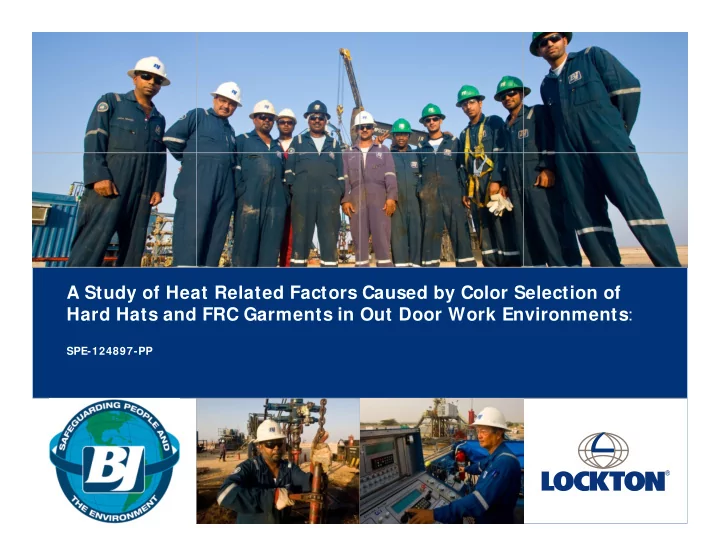

A Study of Heat Related Factors Caused by Color Selection of Hard Hats and FRC Garments in Out Door Work Environments : SPE-124897-PP
Hypothesis � Does the color of the fabric or hard hat affect the potential heat stress on a worker in the sun? � If there is a difference, which color would contribute least to potential heat stress? � Would the data clearly suggest which color to select? � What criteria should be used to evaluate any potential heat stress created by the color of the fabric or hard hats?
Objective � Would changing the color of the FRC coveralls and hard hats from dark blue to a lighter color reduce potential heat stress for employees working in hot outdoor environments?
Management Considerations � Current investment of $x millions � Thousands of FRC coveralls used annually � Thousands of hard hats used annually � Logistics of changing � Branding change
Test Materials � The FRC clothing currently worn is a mixture of fabrics cotton/nylon blends or treated cotton, from 4 different manufacturers – All are dark blue color. � The hard hats are Type 1 class E & G constructed from HDPE. – Dark blue, Green, White
Air Temperatures Above 98.6 o F � When the ambient temperature is above body temperature, then radiation, conduction and convection all transfer heat into the body. � The only mechanism left to cool the body is evaporation of perspiration. 5
Cooling Load = 90 Watts
Hard Hat Surface Temperature Hard Hat Surface Temprature by Color 160 149.1 141.7 140 134 132.48 126.4 120 111.2 100 100.1 99.7 98.6 96.98 Temperature o f 93.9 92.6 Dark Blue Dark Green 80 Light Blue White 60 40 20 0 Average 12:30 12:45 1:00 1:15 1:30 Time p.m. Figure 2
Radiant Heat Radiant Heat Inside Hard Hat by Color 106 104.9 104.4 104.4 104 102.9 102 102 102 100.6 100.3 Temperature o f 100.2 100 99.98 Dark Blue Dark Green 98.6 White 98 97 96 94 92 Average 12:30 12:45 1:00 1:15 1:30 Time Figure 3
Water Evaporation Rate Grams of Water Evaporated by Hard Hat Color 35 30 25 20 Grams 15 10 5 0 Dark Green Dark Blue White Figure 5 � The dark blue evaporated up to 60% more water during the 60-minute test cycle. The increased water evaporation rate indicates a higher heat stress load.
Fabric Color Radiant Heat by Fabric Color 108 106 104 F 102 s e e r g e D r 100 u t a r e p m e T 98 96 94 92 Dark Blue Tan Light Gray Figure 6 The temperature differential between the dark blue and light gray fabric color is up to 9 o F
Surface Temperature of FRC Clothing Average Surface Temperature by Color 140 120 100 o f e r u t 80 a r e p m e T e 60 c a f r u S 40 20 0 Dark Blue Medium Blue Grey Tan White Figure 7 The temperature differential between dark blue and Gray is 25 o F. between dark blue and White is 45 o F.
Test Methods � Quest Temp model 34 Heat Stress Monitors. � Measuring wet bulb, dry bulb, and globe temperatures.
Test Methods � Started and completed within 60 minutes of solar noon. � Two test sessions � Full sun exposure � Air Temperature 92 o F + 2 o F
Data Summary; Hard Hat Color � The surface temperature of the dark blue hard hat was 149 o F compared to 100 o F for the white. � The radiant heat measured under the dark blue hard hat was 105 o F compared to 100 o F for the white. � The dark blue colored hard hats evaporated up to 60% more water than white.
Data Summary; Coveralls � The peak surface temperature in full sun of the dark blue coverall fabric was 129 o F compared to 109 o F for the light gray. � The radiant heat temperature under the dark blue coverall fabric was 106 o F compared to 97 o F for the light gray.
16 Additional Heat Load
Conclusions � Dark Blue Hard Hats and FRC coveralls increase heat loading by 557% compared to the white hard hats and light grey FR coveralls. � Additional cooling load drops from 151 Watts to 23 Watts with white hard hats and light grey garments. � Only evaporative cooling functions at temperatures above 98.6 o F 17
Considerations � If your branding requires dark clothing consider: – Job planning – Additional education – Hydration – Wellness program – Engineering � Shade � Airflow � Shielding
Next Steps � Evaluate the effect of various FRC materials on heat loading including: – Evaporative cooling – Heat conduction – Radiant heat – Convection
Questions? Presented by: Jake Graf & Michael Davis
Recommend
More recommend